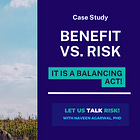LTR Weekly Digest #12 - 11th November, 2023
Catch up on this week's articles: case study about benefit-risk, LTR conversation about building equity in design controls, and a quick reminder to use a patient-focused method for estimating risk.
Dear colleagues, hello! 👋
➡️Benefit-risk evaluation for a medical device is directly tied to the regulatory question of safety and effectiveness, but it proves to be quite challenging in practice. To be judged as safe and effective by regulatory authorities, benefits of a medical device must outweigh risk, and it must provide clinically significant results to a large proportion of target patients. There is a lot of clinical judgement involved in benefit-risk determinations. As discussed in this case study, benefit-risk of a device can fall below expectations despite solid clinical data and favorable patient perspective.
Risk practitioners should take note of the relative nature of benefit-risk determinations and consider including a variety of perspectives in their internal evaluations.
➡️If a device is approved/cleared by the US FDA, we expect it to be safe and effective across the entire patient population within the scope of its intended use. Yet, current industry practices in design, development and testing of medical devices inadvertently introduce many inherent biases in these devices that can lead to preventable harm in some patients.
In this Let’s Talk Risk! conversation, Lori-Ann Archer talks about a need to address this issue by building equity in medical device design control right from the start.
➡️Did you know that simply using number of devices sold, or procedures performed, may not always be accurate for estimating the rate of occurrence of harm. As an example, you may be inadvertently underestimating risk where an individual patient may undergo multiple cycles of the same treatment to achieve the intended benefit.
This quick tip reminds us to use a patient-focused method when estimating risk.
Upcoming Events
LTR monthly webinar series: why FMEA alone is not sufficient for risk analysis.
A quick reminder to join me in this month’s webinar, where I will review the ISO 14971 requirement for risk analysis, identify some of the limitations of using an FMEA, and share a practical tip to link an FMEA with Hazard Analysis for a more complete analysis.
If you are a paid subscriber, you will receive an email with a link to register for this month’s webinar on November 14, 2023 at 11:00 AM EST. You don’t need to pay extra.
If not, you can still attend this webinar with a one time payment of only $25. Click the link below to make a payment and secure your spot. Once you complete the payment, you will receive the registration link by email.
LTR weekly conversations on LinkedIn: how collaboration and knowledge sharing can help overcome practical challenges in risk management
Join me next Friday, November 17, 2023 at 11:00 AM EST, for another Let’s Talk Risk! conversation on LinkedIn. My guest next week is Bijan Elahi, who discuss how collaboration and knowledge sharing can help us overcome practical challenges in risk management. Click below to learn more and add it to your calendar!
Weekly Knowledge Challenge #10
I hope you enjoyed the knowledge challenge question last week. Here is the correct answer:
The statement “since it is not an explicit requirement of ISO 14971:2019, there is no need to evaluate benefit-risk for a medical device during the production and post-production phase of the lifecycle”, is FALSE.








